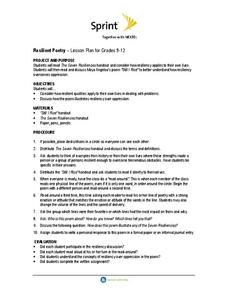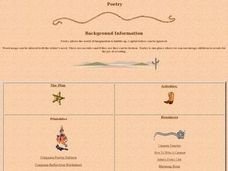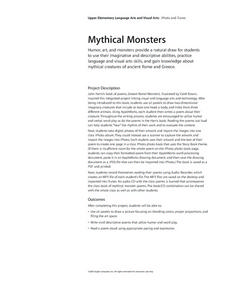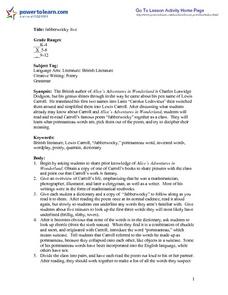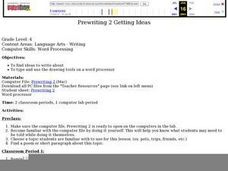Curated OER
Resilient Poetry
Students read The Seven Resiliencies, a Maya Angelou poem, and complete writing activities to analyze the concept of resiliency. In this poetry lesson, students group in a circle to read the resiliency handout and discuss the text....
Curated OER
Beginning Sounds: Poem
Students practice identifying beginning sounds. In this phonics instructional activity, students review different beginning sounds and read a poem. Students then work together to identify the words in the poem with their particular...
Curated OER
Magnet Poetry
Students engage in a lesson that involves the use of imagery in poetry. They select words from poems that are used for imagery. The words are put onto magnets and then used to create new poems filled with imagery. The hands on connection...
Curated OER
Writing Bug: a Friendly Poem
In this writing worksheet, students will write a poem about their best friend by using all of the letters in their first and last names.
Curated OER
Focus On Figurative Language in Prose
Students examine the use of literary prose in the story, "Dark They Were, and Golden-Eyed." In this literary prose lesson, students investigate the use of imagery, metaphor, and simile in the story. They tell how author's purpose is...
Curated OER
Poetry - Cinquain Poems
Students write cinquain poems. In this poetry lesson, students participate in activities related to poetry and write a cinquain poem. Included are links to the lesson plan, lesson activities, printables, and additional resources.
Curated OER
Figurative Language 2
Students read nursery rhymes and advertisements to identify examples of figurative language. As a class, students discuss the use of figurative language and its effectiveness in advertising, children's books, rhymes, poetry, etc. ...
Curated OER
Art and War
Students analyze art and war and the Futurist movement. In this art analysis instructional activity, students define manifesto and its role with artistic movement. Students explore art as a response to political and social issues through...
Curated OER
Number The Stars Diamante Poem
For this language arts worksheet, students read the rules and format for a diamante poem. They fill in the lines on page 2 while following the guidelines.
Curated OER
Diamante Poems
In this language arts worksheet, students are guided in the process of creating diamante poems. Then they create their own from the choices given.
Curated OER
Mythical Monsters
Students design mythical creatures and write poems about them. They take digital pictures of their artwork and create a digital picture book. They record their readings of the poetry to be added a class recording.
Curated OER
Food and Dialect
The dialect words for types of food from across the British Isles get pupils thinking about native dialects and how they differ from Standard English. Class members create a dialect dictionary and discuss the difference between accent...
Curated OER
Jabberwocky-Identifying Adjectives
Elementary learners identify adjectives in sentences. They read the poem "Jabberwocky" by Lewis Carroll and highlight the adjectives. A good supplemental lesson if you are studying Lewis Carroll and/or "Jabberwocky."
Curated OER
Concepts of Beauty Put Into Words
Studying haiku poetry with your English class? Delving into Japanese history with your world history class? Here is an authentic and creative way to explore Japanese culture more deeply. Pupils will compare and contrast two tea caddies...
Curated OER
"Jabberwocky" Jive
Pupils review the fantasy of Alice in Wonderland and discuss the author. After reading the poem, "Jabberwocky," they look up unfamiliar words in the dictionary. Working as partners, they create a list of "protmanteau" or invented words...
Curated OER
Weather and Dialect
What's the difference between an accent and a dialect? Examine the difference between the two with your scholars. In groups, they compile a dialect dictionary. They interview adults to gather information about accents and ethnic words....
Curated OER
Interpreting Meaning in Maya Angelou’s “I Know Why the Caged Bird Sings”
Launch a study of Maya Angelou's "I know Why the Caged Bird Sings" with the Youtube video of Alicia Keys singing her "Caged Bird." Groups then read Angelou's poem and discuss the symbols employed. Although the text of the poem is not...
Curated OER
Connotation: "My Papa's Waltz" by Theodore Roethke
What's happening in this poem? Have your high schoolers participate in an activity about connotation and denotation. They apply the concept of connotation to a reading of Theodore Roethke's poem "My Papa's Waltz." Lead a discussion about...
Curated OER
Tell Me A Story -- Feelings
Practice using feelings as a way to reflect on past experiences. The poem The End and the text Tell Me a Story Mama are used to identify feeling words. As an extension, pupils participate in a service learning project and reflect upon...
Curated OER
Literary Response and Analysis
Examine a variety of literary responses to Abraham Lincoln's death and the impact of perception. Your class can work in writing groups to analyze either poetry, eulogy, or a newspaper article. They retell the events of Abraham Lincoln's...
Japan Society
Our Family and Other Families: Using Totoro to Teach Family Structure
What do families around the world have in common? Explore this theme through the popular animated film My Neighbor Totoro by Hayao Miyazaki. Over the course of two days, pupils view the film, pausing to discuss their own families and the...
Curated OER
Pride and Prejudice: Biopoem
Describe yourself or a character from Jane Austen's Pride and Prejudice with a biopoem activity. Using the provided format, kids write their own characteristics or the character traits from the novel to create a poetic portrait.
Curated OER
Prewriting 2 Getting Ideas
Fourth graders read a poem or short paragraph and have students picture it in their minds. They relate the topic to something in their experience and illustrate, 4th graders generate questions with a graphic organizer, use Prewriting2...
Curated OER
Slavery in Colonial America
Students examine the experience of the middle passage of slaves. They review slave songs and discuss their common themes. They develop a monologue in which they integrate a fragment of an actual slave song into a poem they have written.


